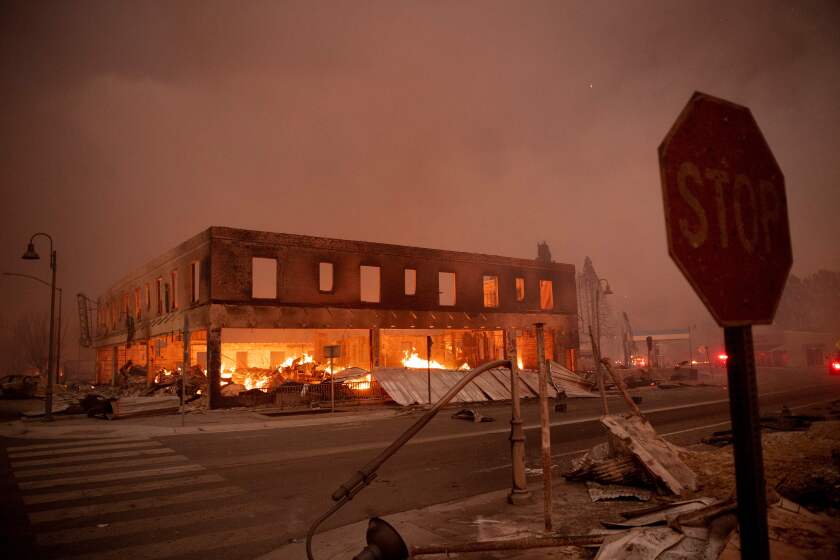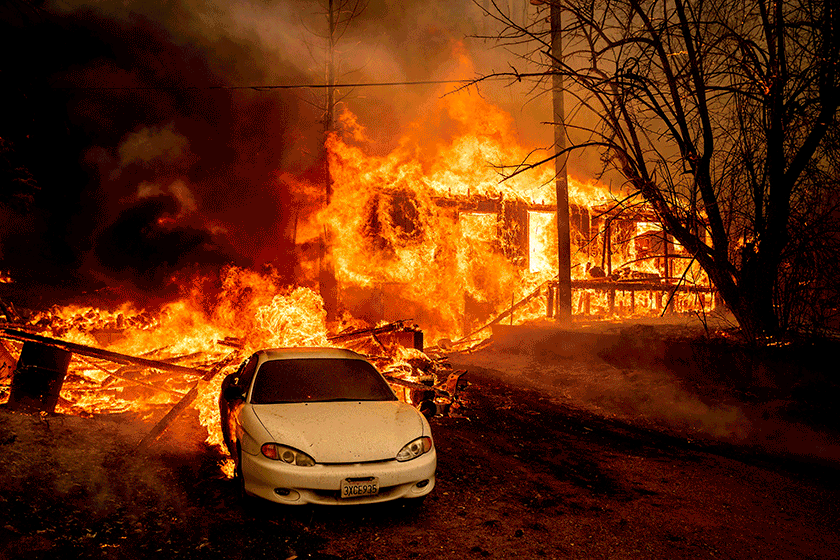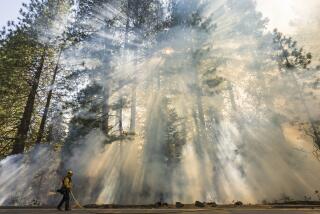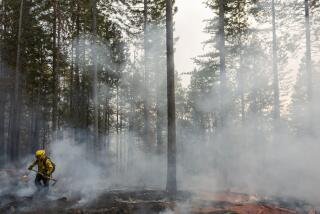Dixie fire forces new evacuations and strains resources as it burns for more than a month
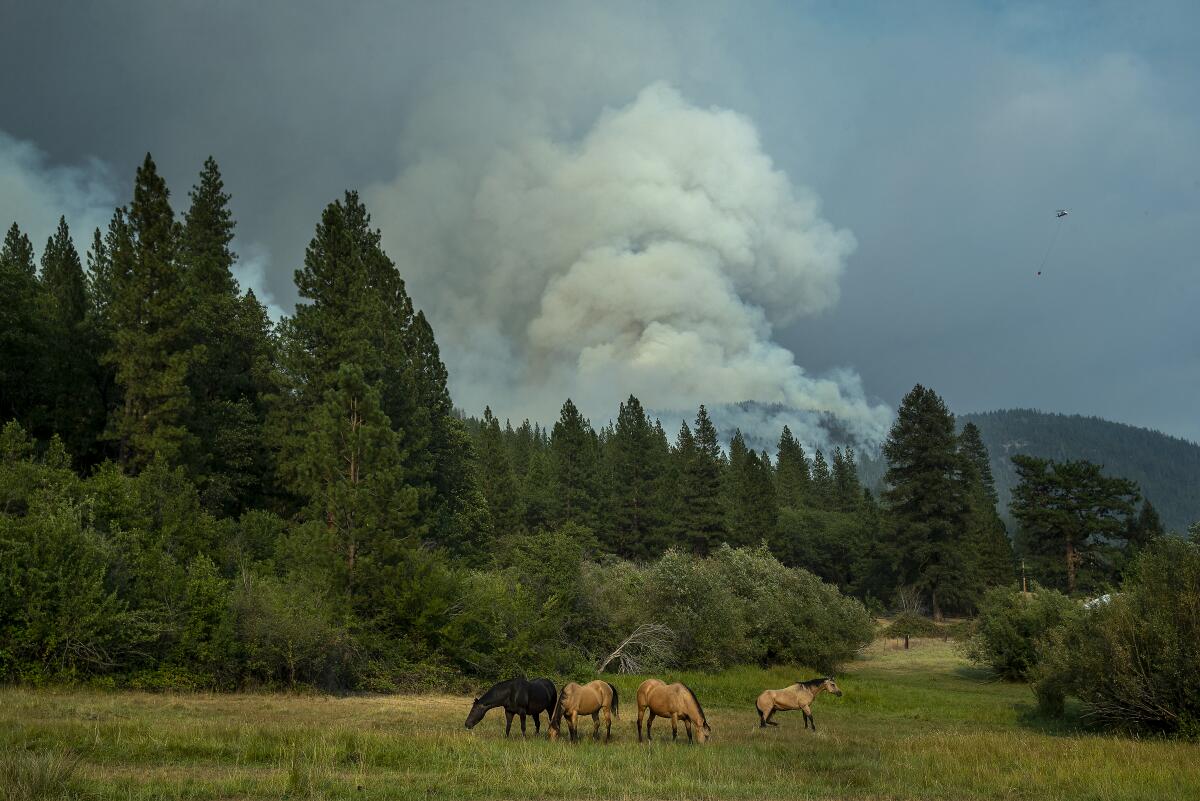
More than a month after it ignited near a Pacific Gas and Electric Co. power station in Feather River Canyon, the relentless Dixie fire shows no signs of slowing down as it continues to threaten homes and strain firefighting resources.
The fire had burned 540,581 acres, destroyed at least 738 residences and commercial properties and forced nearly 29,000 people from their homes as of Saturday morning, authorities said. Nearly 15,000 structures remained threatened.
The fire made a number of significant runs Friday, sending up multiple large columns of ash and smoke that in at least one case generated its own lightning, officials said. Its ferocity has stunned even veteran firefighters, adding an element of unpredictability that makes it difficult to determine when they’ll be able to get the upper hand.
“‘Typical’ is a challenging word for us,” said Dan McKeague, public information officer with the U.S. Forest Service, noting the massive fire is unusual in both its sheer size and its erratic behavior. “When you have the combination of this active a fire over this big of a landscape, there’s not much typical about it.”
The fire, which was 31% contained, prompted new evacuation orders for Genesee Valley on Friday night as thunderstorms swept through, causing erratic outflow winds that increased fire activity, McKeague said.
“You can have really sudden changes in terms of the wind direction when we have those outflow drafts,” he said. “If you picture a faucet where water is coming down and then when it hits the sink it spreads out in all directions, that’s what that air is doing as those pressure systems interact.”
Fire officials were eying Saturday’s conditions nervously, as a smoke inversion that had put a cap on the fire earlier in the week had cleared out, he said.
“That puts more sun on the fire, and potentially more air movement,” he said. “That’s not a good thing in terms of fire behavior.”
Firefighters on the western flank of the fire saw a lot of activity along Highway 36 between Chester and Westwood, where crews put in 50 to 100 feet of contingency line, said Edwin Zuniga, public information officer with the California Department of Forestry and Fire Protection.
“A lot of structure protection resources are being assigned to that specific area to protect the peninsula on Lake Almanor, the cabins along that stretch of Highway 36 and the community of Westwood,” he said.
The weather was continuing to pose a challenge, with hotter and drier conditions forecast for the next couple days, he said.
Pacific Gas & Electric is under rising scrutiny this summer as a series of huge fires across Northern California have raged amid hot, dry conditions.
Temperatures in the area of the fire were expected to reach anywhere from the upper 80s to just shy of 100, depending on the smoke cover, said Scott Rowe, meteorologist with the National Weather Service in Sacramento.
The Dixie fire ignited July 13 near the spot where a tree fell into a PG&E power line. The utility has said it took a worker about 10 hours to reach the remote site and observe flames.
Although the cause of the fire remains under review, prosecutors in at least two counties are investigating PG&E for potential criminal charges, saying it should have been aware of the high risk of fire in the canyon. It is the same canyon where PG&E equipment ignited the 2018 Camp fire, which saw the utility plead guilty to 84 counts of manslaughter after the town of Paradise was decimated. PG&E had planned to bury the power line that might have started the Dixie fire as part of a safety campaign announced in the wake of the Camp fire, but work on the project hadn’t yet begun.
The Dixie fire took off amid extreme conditions, as human-caused climate change has sent temperatures rising and upended the natural patterns of precipitation on which California relies to supply its ecosystems with water.
The state this year saw its hottest June and July on record, with the heat most intense in the interior areas where the fire is burning, Rowe said.
Authorities have also blamed a century of aggressive fire suppression for creating patches of forest that are overgrown with thick understories of dry brush and in some cases enabling invasive species to move into areas where more frequent, low-intensity fires would once have kept them out.
The conditions have aligned to produce an intense, active fire season that has stressed resources, resulting in shortages of personnel and equipment that are being felt nationwide.
More than 6,500 personnel were assigned to the Dixie fire — about a quarter of the nearly 25,000 people who were out fighting more than 100 large uncontained fires nationwide, according to the National Interagency Fire Center.
“And yet there are some critical positions that we’re unable to fill as frequently as we’d like,” McKeague said. “That includes our division supervisors, our dozer operators, our hotshot crews and even some critical line medic positions that are responsible for any medical emergencies for our firefighters.”
That comes after the National Multi-Agency Coordinating Group recently issued memos warning firefighters of a shortage of radio communications equipment and advising those arriving to incidents to bring enough food and water to be self-sufficient for three days due to a high demand for supplies.
Although there have been no specific actions firefighters were unable to complete due to the personnel shortages, they’ve at times found themselves with not as much coverage on certain areas of the fire as they’d like, McKeague said.
“With a fire this big and this active, we certainly would be putting any and all of those additional resources to use, if they were available,” he said.
One challenge for fire crews in Plumas County is residents who won’t leave their property, forcing firefighters to take risks on their behalf.
There was also a 10% to 15% chance of more thunderstorms moving over the fire Saturday, causing officials to warn firefighters on the line to be aware of potentially changing conditions, including the possibility of ground lightning strikes, according to authorities.
“With fuels that are this dry, historically dry, you always run a good chance of those causing new ignitions,” McKeague said, noting the probability of ignition — essentially the chance that an ember that lands in vegetation will start a new fire — has consistently been between 90% and 100%.
In a normal year, vegetation in the Sierra Nevada goes through a spring “greenup,” sucking up moisture, then blossoming and putting on new growth before it goes dormant in the dry summer months, as it is evolved to do, said Ryan Bauer, fuels and prescribed fire program manager for the Plumas National Forest. At that point, the vegetation starts to burn like it’s dead even though it’s alive.
This year, Bauer said, precipitation was sparse and fell early in the season so the live vegetation never reached its full moisture content before it started going dormant.
“So it’s all critically dry right now,” he said. “The brush is burning just like dead fuel.”
That also resulted in conditions being ripe for active fires starting earlier in the year. Normally, he said, the Plumas National Forest wouldn’t really enter its fire season until mid-July. This year, it started in mid-May. It is expected to last through September if not October.
“We’ve been in fire season for a long time,” he said, “and we’ve still got a lot of fire season ahead of us.”
More to Read
Sign up for Essential California
The most important California stories and recommendations in your inbox every morning.
You may occasionally receive promotional content from the Los Angeles Times.
